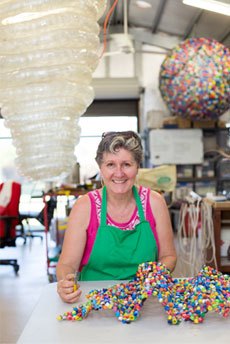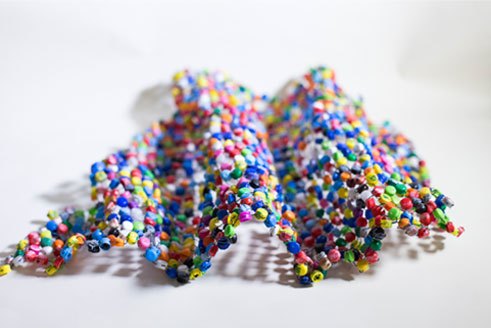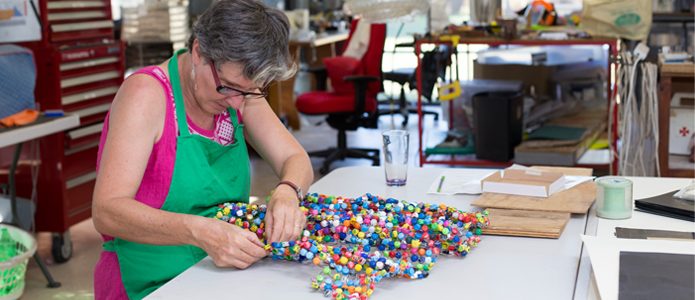As a sculpture student, Alison McDonald often couldn’t afford material like bronze. That sparked the Australian artist’s career in reinventing discarded items.
People tell Alison McDonald her art is just rubbish. She couldn’t agree more. Her work challenges the throw-away society we have become, with pieces ranging from huge public installations made out of discarded plastic bottle tops to delicate earrings from plastic fish that used to hold soya sauce for sushi. Alison describes herself as a sculptor revaluing everyday materials. She likes to use the word “upcycle” rather than recycle. “It’s giving people the sense that waste can be given a new lease of life and a new value, not necessarily a monetary value,” she says. “Some people go, ‘Yuk - that’s just plastic,’ but most people love it.”
The Geelong native adds: “I’d rather make art that is about everyday life and people, rather than high art with really expensive materials. When you use those expensive materials, you have to be very careful and you are not free with your art. If you are working with a plastic bottle, you are more playful.”
THE HABIT OF PUTTING A LID ON THE COKE
She ventured upon the path of working with rubbish just over a decade ago. As a sculpture student, she often couldn’t afford material like bronze. But in those early days, Alison’s husband liked to drink a lot of coke. That meant lots of plastic bottles and bottle tops. Instead of throwing them all in the recycling, the art student made a big public art work out of the rubbish. She created some enormous five metre jellyfish out of the PET plastic bottles, together with nylon fishing line, wire and electrical ties for the Strand Ephemera, an open air sculpture exhibition in Townsville, Northern Queensland.
The region is well known for its jelly fish, or “stingers”, some of which can kill a person. Swimming is not advised during marine stinger season, which extends from October to June. The stingers are beautiful, but dangerous – a bit like the danger confronting society through the plastic we have come to rely upon so much, but which creates so much waste. And whilst Alison had created some beautiful jelly fish out of the bottles, she still had a lot of bottle tops left! So she took the next step towards becoming a rubbish artist.
GO WITH THE FLOW
The bottle tops, ultimately tens of thousands of them, became part of Flow, a massive, multi-coloured installation originally displayed on the side of the Umbrella Studio in Townsville, like a waterfall of rubbish.
“Flow is like a piece of fabric and it’s about all the stuff that flows down the waterways into the ocean,” says Alison. “People usually have to touch it and work out what it is. And they discover it’s just plastic lids.”
Soon, adding to the artist’s own collection of bottles tops were those collected by family, friends, and strangers, who would appear with bottle tops without being asked.
-
 © Photo (CC BY-ND 4.0): Aaron Ashley
© Photo (CC BY-ND 4.0): Aaron Ashley
Flow: Upcycled plastic lids and cable ties, 12 x 7 metres, 2010-2013
-
 © Photo (CC BY-ND 4.0): Aaron Ashley
© Photo (CC BY-ND 4.0): Aaron Ashley
Alison in her studio with Ball and other work in the background
-
 © Photo (CC BY-ND 4.0): Aaron Ashley
© Photo (CC BY-ND 4.0): Aaron Ashley
Trickle: Individually hand cast and reduced recycled plastic lids and wire, 100 x 60 x 1cm, 2013
-
 © Photo (CC BY-ND 4.0): Aaron Ashley
© Photo (CC BY-ND 4.0): Aaron Ashley
R.R.R.: Recycled hand cut and coloured PET plastic, silver coated wire, 68 x 20 x 38 cm, 2012-2015
-
 © Photo (CC BY-ND 4.0): Aaron Ashley
© Photo (CC BY-ND 4.0): Aaron Ashley
Fractal 2: Recycled hand cut PET plastic bottle, Triptych 100 x 32 cm, 2008
-
 © Photo (CC BY-ND 4.0): Aaron Ashley
© Photo (CC BY-ND 4.0): Aaron Ashley
Fractal 3: Recyclete und handgeschnittene PET-Flasche, Triptychon 100 x 32 cm, 2008
“I would go into town and come back to the car and find a bag of lids on it.” Alison found her household was not the only one that had been storing plastic bottle tops. The family of one woman who used to save lids donated the collection to the artist after the woman died of breast cancer. Alison held workshops where the public could come and help assemble the Flow artwork. The daughter and the granddaughter of the deceased woman came and helped. It was an emotional moment. “We all ended up in tears of course. And they were very pleased that they didn’t have to throw her materials out and that they went towards an artwork,” says Alison.
“It’s a very community-involved art work, and I think that strengthened it,” the artist relates.
THINK GLOBAL, REUSE LOCAL FISH
To reflect the impact of plastic bottle tops, Alison has created Global – a 1.2 metre spherical structure, again of “upcycled” bottle lids, but with an international twist. Every time friends go overseas, they bring back lids with writing in different languages on them. “I’ve lost count of the number of countries,” she laughs.
Alison hopes her work will teach people about revaluing materials, and to learn about sustainability: “We have to think differently. Just because people say its rubbish doesn’t mean it is.”
And Alison thinks she is having success. At the jewellery stalls she sometimes has at markets, people want to hear where the materials come from. “People love that there’s a story behind it and that the item’s having another use.”
Her sushi fish earrings – plastic soya sauce bottles with old telephone wire woven around them – are popular. Alison is conscious of the absurdity of the ubiquitous little fish: “In a few hundred years, an archaeologist digs up a sushi fish and tries to work out what they are used for. Imagine their face when they realise that it’s something we put sauce into, used it and threw it away. Something we only had in our hands for a few seconds.”
A SHIMMERING MESSAGE
Alison likes to make beautiful things out of objects that others think nothing of throwing away. But it sometimes takes a while for her to understand what she is going to do with the items she stores. For five years she had more than 7000 power pole inspector identification disks at her house, while she pondered what to do with them. The little aluminium disks, which show the type of timber used in power poles and report any defects or termite infestations, would only be used for four years and be thrown away.
She has now used them to create Shimmer, wrapping a Surf Life Saver's Tower in the disks, which move in the wind to reveal the red or yellow undersides of the disks. The Towers are raised platforms on patrolled beaches where life guards can keep an eye on swimmers in the water and keep a watch out for sharks, rips and other dangers. Red and yellow are the colours of Australia’s iconic Surf Lifesavers. “I try to link the item with the message. The shimmer on the water is alluring, trying to get you in. It’s beautiful but it’s also dangerous, and that’s why you need the Lifesavers in the background.”
THROW AWAY SOCIETY
Alison McDonald wants people to reuse materials. And she has a particular message for parents. “If you do art with kids you don’t need a lot of money, you just have to look in your bin.” And she would like people to think twice before throwing things away. “Away… Where is that?” the artist asks.
